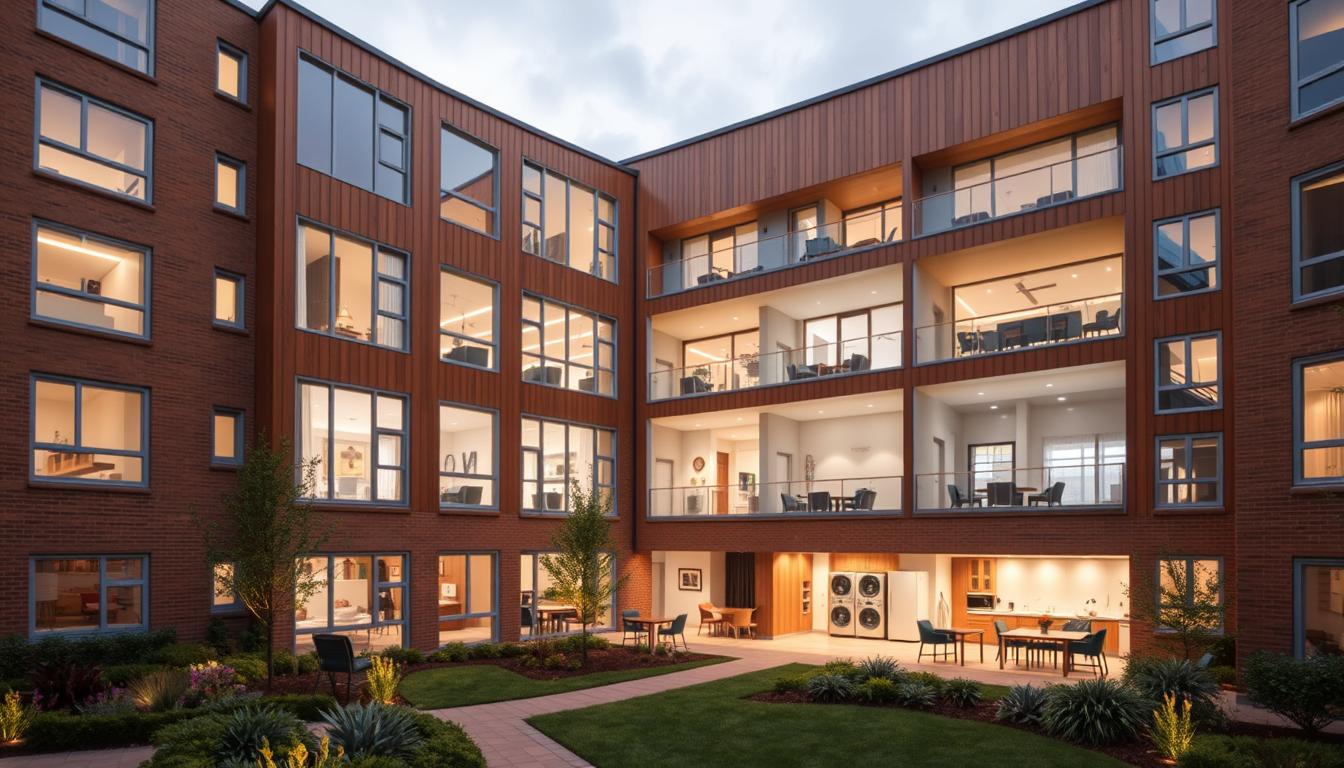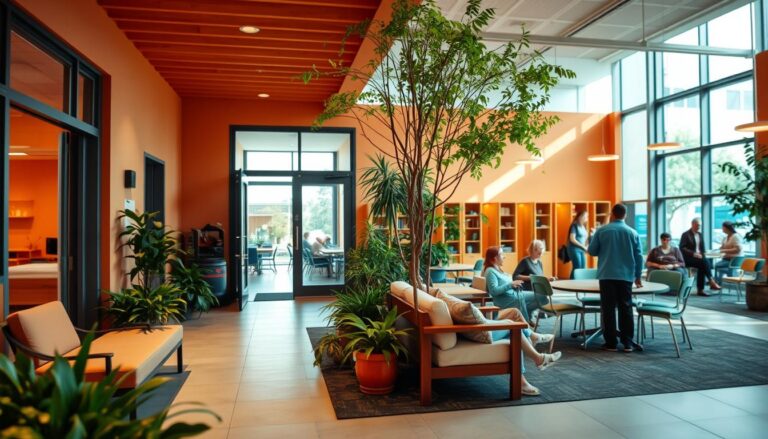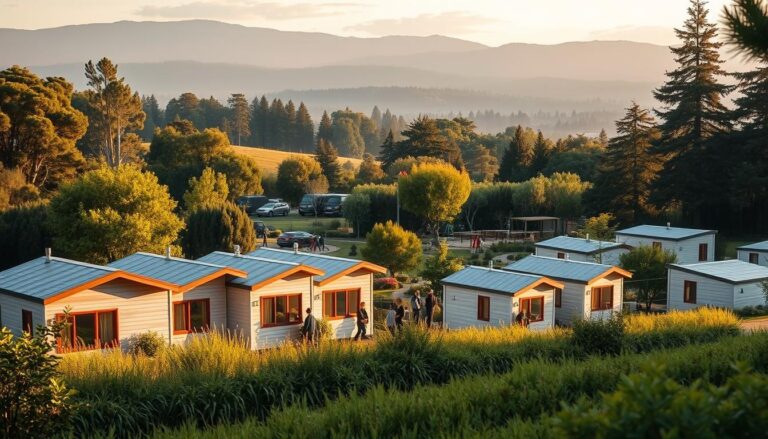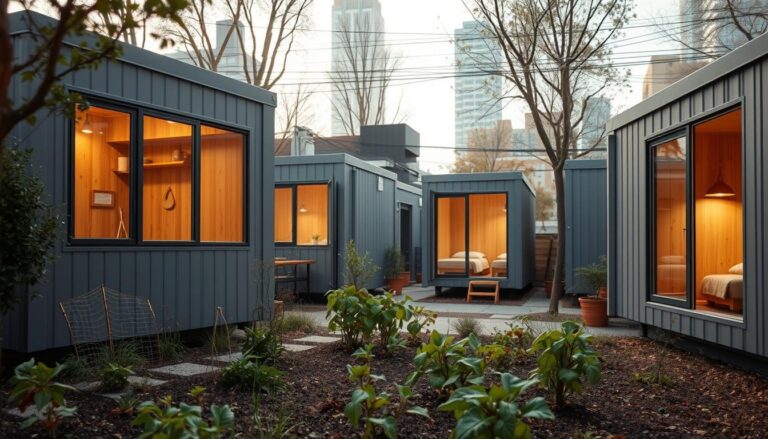Unlock Stable Living: Long Term Housing for Homeless
Finding a stable home can change lives for those without one. Long term housing for the homeless offers more than just shelter. It brings security and stability. The Unlocking Doors pilot initiative plans to spend $10 million to fix up affordable homes. This program connects people from shelters with fixed-rent apartments using CityFHEPS vouchers.
There has been a 10% increase in moving people from shelters to permanent homes. This shows these programs work. But, affordable housing is still hard to find. Less than 1% of apartments are affordable for many homeless people. By reinvesting in affordable units, we can fight this crisis better.
We explore housing help for the homeless, the need for lasting housing, and success stories. Understanding and action can lead to a brighter future for those in need. Your help can make a real difference.
Understanding Homelessness in America
To truly understand homelessness in America, we must look at the stats and why it happens. Over 650,000 people are homeless each night here. Nearly 30% of them face serious mental health issues. A mix of factors leads to this deep issue.
Statistics on Homelessness
Think about this: 11 million very low-income families spend half their money on housing. This puts them in danger of losing their homes. Since the mid-1980s, affordable housing has been hard to find. This has made the housing crisis worse.
The main help from the government is the Housing Choice Voucher Program, known as Section 8. It helps a lot but only reaches 25% of those who need it. Permanent supportive housing helps those with chronic illnesses or disabilities. It aids those who have been homeless a lot. Rapid re-housing offers quick rental help and services, helping families find homes fast.
Factors Contributing to Homelessness
Knowing why homelessness happens shows we need big solutions. The gap between high housing costs and low incomes is a huge part. In California, around 161,548 people were homeless on a single night in January 2020. About 70% of them had no proper shelter.
In 2021, more than 270,000 people used homelessness services in California. But affordable places to live are rare. There are only 23 affordable homes for every 100 low-income renter households. California needs about 1.2 million more affordable homes by 2030. This shows how critical affordable housing is in solving homelessness.
The Importance of Long Term Housing for Homeless
Long-term housing helps improve the lives of those without homes. It offers a steady place to live. This kind of support leads to better mental health and happiness.
Benefits of Stability and Security
Having a secure place to live reduces stress and worry. It takes away the fear of not knowing where to sleep. It also helps people feel like they belong to a community, which is key for recovery.
Impact on Mental Health and Wellbeing
Having a stable home improves mental health. It lowers the chance of drug use and helps people use healthcare more. People use mental health services less and spend fewer days in the hospital. Long-term housing not only improves lives but also helps healthcare systems.
Exploring Long Term Housing for Homeless
It’s key to know the long term housing options to help solve homelessness. Various types meet different needs, moving people to stability. Transitional and supportive housing are two main types, each aiding certain groups.
Types of Long Term Housing Solutions
Housing for a long time is crucial for homeless support. Available options are:
- Transitional Housing: Offers temporary places to stay, helping people become independent. It includes learning new skills and case management services.
- Supportive Housing: For those dealing with chronic problems, it provides a permanent home and ongoing support, like healthcare and counseling. It’s ideal for those facing long-term homelessness.
Comparing Transitional Housing and Supportive Housing
Knowing the difference between transitional and supportive housing is crucial. Below is a table showing key differences:
| Feature | Transitional Housing | Supportive Housing |
|---|---|---|
| Duration | Temporary (typically 6-24 months) | Permanent |
| Services Offered | Skill-building, case management | Healthcare, counseling, support services |
| Target Population | People ready for change, working towards independence | Individuals with chronic issues requiring ongoing assistance |
| Residency | Shared or individual units | Private units or shared accommodations |
This understanding allows providers to offer solutions that truly help the homeless.
How Transitional Housing Assistance Programs Work
Transitional housing helps people move from homelessness to a stable home. It’s for those at risk of losing their homes. These programs offer housing for six to 24 months. They teach life skills, how to manage money, and help find jobs. This plan helps people become self-reliant.
Structure of Transitional Housing Programs
Groups like Volunteers of America help homeless veterans and others in need. They aim for stable living and building skills. The Housing First approach is key, getting clients housed quickly. Once housed, they get case management for homeless individuals. This connects them to homeless housing resources and support.
Case Management and Support Services Offered
Case management for homeless individuals tackles the hard parts of being without a home. Case managers set goals with clients for a better future. They link clients to job training, healthcare, and schools. Ongoing support ensures they stay housed and grow stronger.
Permanent Supportive Housing Solutions
Permanent supportive housing is key in offering long-term, affordable places to live for those needing extra help. It combines housing with support services that cater to various needs. This differs from transitional housing by not having a time limit. This helps people find the stability they need for a hopeful future.
Understanding Permanent Supportive Housing
Permanent supportive housing aims to help those without homes, especially if they have disabilities or chronic health issues. To apply, one must be 18 or older, linked with a human service agency, and earn less than 50% of the median income in the area. These properties often have units designed for people with disabilities. More than 85% of residents stay put, showing the effectiveness of these programs in keeping people housed.
Benefits of Permanent Supportive Housing
Supportive housing offers many benefits for individuals and communities. Residents usually pay 30% of their income towards rent, which might be around $300 if they’re on a disability income of $900. This makes living stable and allows them to be part of the community through jobs, volunteering, and education. Plus, supportive housing helps improve housing stability for the homeless.
With dedicated staff like community managers and maintenance workers, residents get ongoing help. These efforts help residents fit into communities well. Studies show they don’t harm local property values or increase crime.
Affordable Housing for Homeless Individuals
Getting affordable housing is key for those without a home. With rents going up, it’s hard for low-income families to find a stable place to live. There are new ways being tried in affordable housing that look promising. Things like government-issued vouchers and tax credits are helping make housing more available to those in need.
Current Trends in Affordable Housing
In recent times, we’ve seen some great strategies come about to help with housing. Through things like community land trusts and partnerships between the public and private sectors, more housing is becoming available for the homeless. Programs like Permanent Supportive Housing are really making a difference. They help people get into stable homes and offer the support they need. An example is the Palmer Court Apartments by the Road Home, with 201 homes for those in need since 2009.
Role of Government Programs in Providing Housing
Government efforts are crucial in fighting housing problems. Programs like Rapid Re-Housing help with the costs of deposits and initial rents for those who qualify. But there’s more to it than just money. The FAST program offers broader help, looking after things like health and education for families. This not just offers a roof over their heads but also a chance at a better life.
The SSVF program is there for low-income veterans facing the risk of homelessness. It shows there are special efforts for different groups in need.
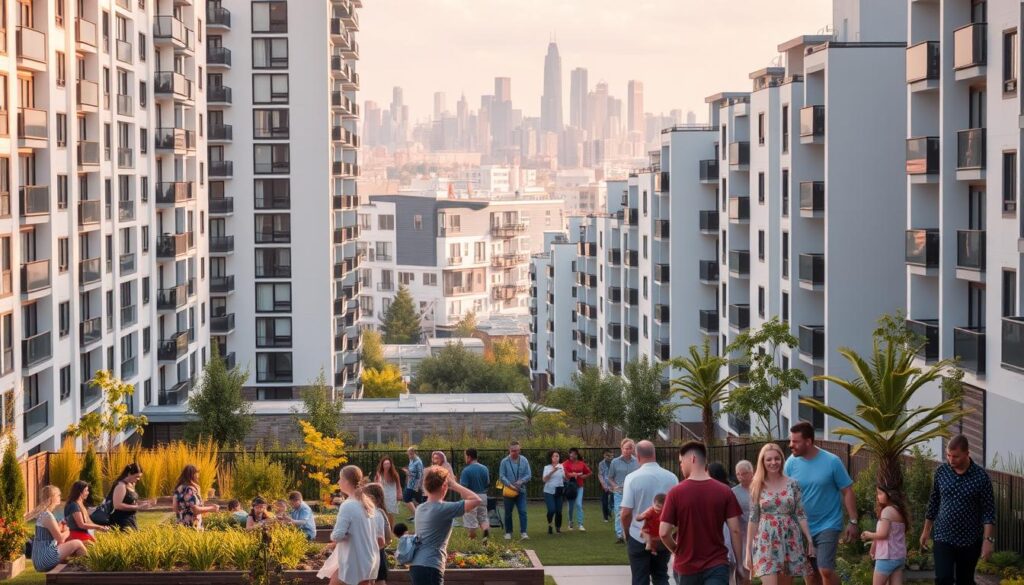
Homeless Housing Options Available in the U.S.
In the U.S., there are many ways to help homeless people find a place to live. These options meet different needs. From emergency shelters and transitional housing to long-term programs, each plays a critical role. Emergency shelters offer a quick place to stay. Transitional housing helps people get back on their feet for a longer term. And long-term programs make sure people can live in their own homes affordably.
Emergency Shelters vs. Transitional Housing
Emergency shelters are a key first step for people and families in need. They provide a safe place to stay for a short time. People also get access to basic needs and help to stabilize their lives. Then, transitional housing is the next step, lasting up to two years. It prepares people for a future in their own homes. This housing includes training and support for jobs and personal growth.
Long-Term Housing Affordability Programs
Long-term housing programs are crucial for tackling homelessness more widely. These programs, supported by the government, offer long-lasting housing solutions. They make homes affordable and provide needed services. This helps people live stable lives well beyond an immediate housing crisis. Such actions are key to reducing homelessness and making communities healthier. By supporting these programs, we work towards fair access to housing for everyone.
Housing Stability Services for the Homeless
Housing stability services help people without homes find lasting places to live. They mix community support with other tools. This helps those in need build a new life. Emergency Rental Assistance (ERA) programs play a crucial role. They stop evictions and keep people in their homes.
Community Resources and Support Systems
Local groups are making big strides in supporting stable housing. In North Dakota, twenty organizations are working together to improve such services. Jefferson County, Alabama, has meetings to prevent evictions. Northampton County connects people with social services quickly. These projects show the strength of communities working together to help people find homes.
Success Stories of Housing Stability Services
There are many success stories from these housing services. In Maricopa County, support like job help has shown real benefits. Delaware’s Housing Stability Program, supported by ERA, gave over $5 million to help organizations. This money helps people not just find homes, but keep them, offering a solid base for the future.
FAQ
What is long-term housing for homeless individuals?
Long-term housing gives homeless people stable and lasting homes. It helps them live independently and supports their mental health.
How do transitional housing assistance programs function?
Transitional housing programs offer a temporary home for 18-24 months. They help with job skills, finding work, and learning about money. These efforts prepare people for a long-term home and self-reliance.
What is the difference between transitional housing and permanent supportive housing?
Transitional housing is short-term and helps people become independent with special support. Permanent supportive housing is long-term. It mixes a steady home with ongoing help for those with lasting issues.
Why is affordable housing critical for homeless individuals?
Affordable housing is key to fighting homelessness because it offers safe places to live. With rent prices going up, it’s harder for those with low incomes to find a home. So, affordable options are needed to prevent homelessness.
What role do community resources play in housing stability services?
Community resources like job training, mental health care, and addiction help are vital. They support people without homes in moving to a stable life and getting better.
How do permanent supportive housing solutions benefit individuals?
Permanent supportive housing gives people a long-term, affordable place to live with needed services. This helps them stay stable and enhances their life quality.
What statistics highlight the urgency of addressing homelessness?
On any night, over 650,000 people in the U.S. are homeless. Around 30% deal with severe mental illness. These numbers show how big and complex the problem of homelessness is.
What innovative approaches are being taken to expand affordable housing?
New methods like partnerships between the public and private sectors and community land trusts are creating more affordable homes. These strategies aim for lasting housing solutions for those experiencing homelessness.
Can you provide examples of organizations that offer housing solutions?
Bodies like Covenant House and the Substance Abuse and Mental Health Services Administration (SAMHSA) offer important services. They have programs for temporary and supportive housing, managing cases, and mental health aid.
